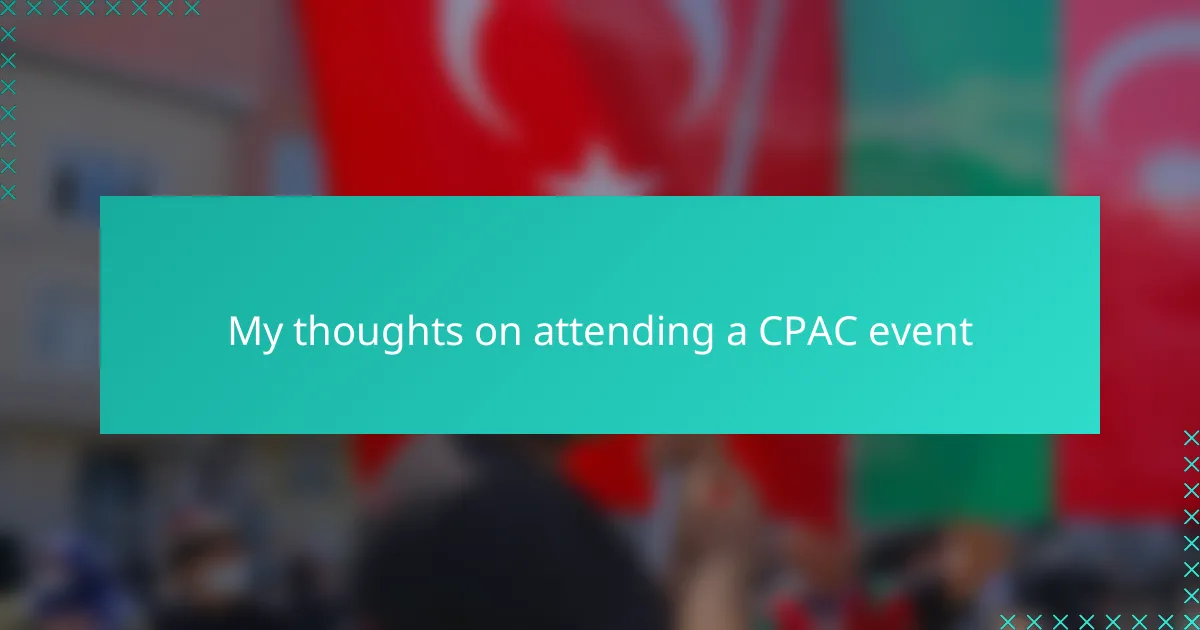Key takeaways
- CPAC serves as a dynamic platform for both established and emerging conservative voices, facilitating the exchange of ideas and strategies.
- Keynote speakers at CPAC have a significant impact, introducing fresh perspectives that inspire attendees and shape political movements.
- The conference emphasizes political strategies like tailored messaging and grassroots mobilization, showcasing the importance of narrative control in influencing public discourse.
- Attendees experience a sense of community and inclusivity, encouraging both tradition and innovation within conservative thought, which fosters political energy and growth.
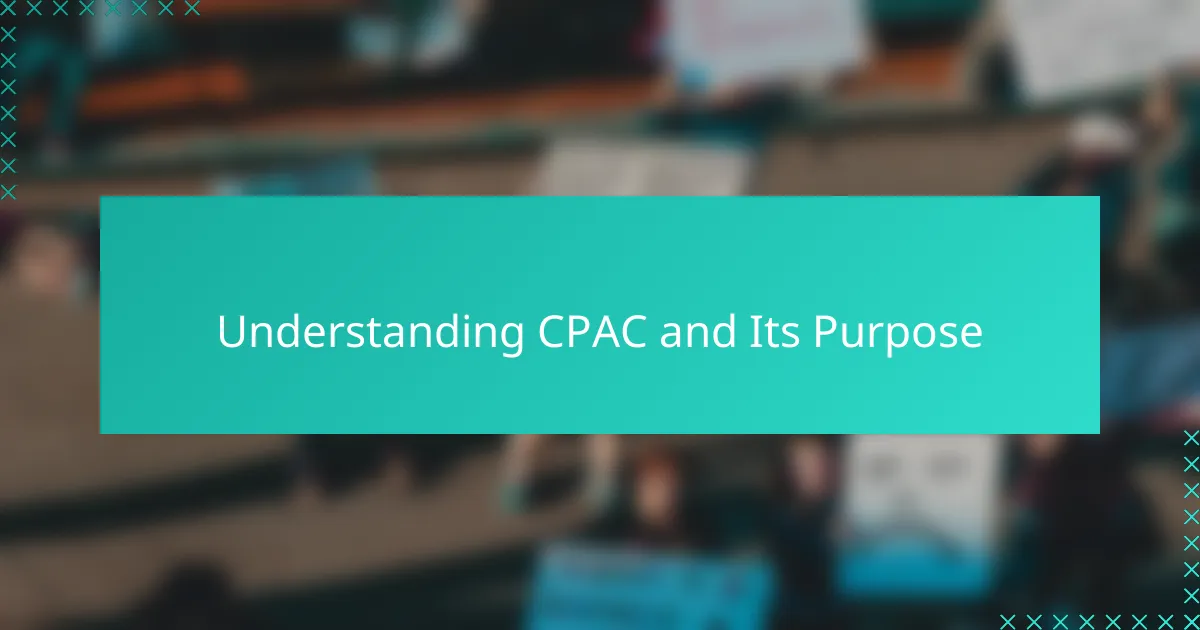
Understanding CPAC and Its Purpose
CPAC, or the Conservative Political Action Conference, is more than just a gathering—it’s a hub where conservative ideas and strategies converge. From my experience, attending CPAC feels like stepping into a dynamic arena where political ideals are passionately exchanged and debated. Have you ever wondered what drives such a focused community of activists and leaders to come together year after year?
The purpose of CPAC is to energize and unify conservatives, which I noticed firsthand through the fervor radiating from keynote speeches and breakout sessions. It’s designed to blend policy discussions with grassroots activism, creating a unique space where big-picture strategies meet on-the-ground realities. This dual focus made me reflect on how political movements sustain momentum beyond election cycles.
What struck me most was CPAC’s role as a platform for emerging conservative voices alongside established figures. It’s not just about echoing familiar opinions but also about shaping the future direction of conservatism. For anyone intrigued by the evolution of political thought, CPAC offers an insightful glimpse into how ideas are vetted and propagated within this influential circle.
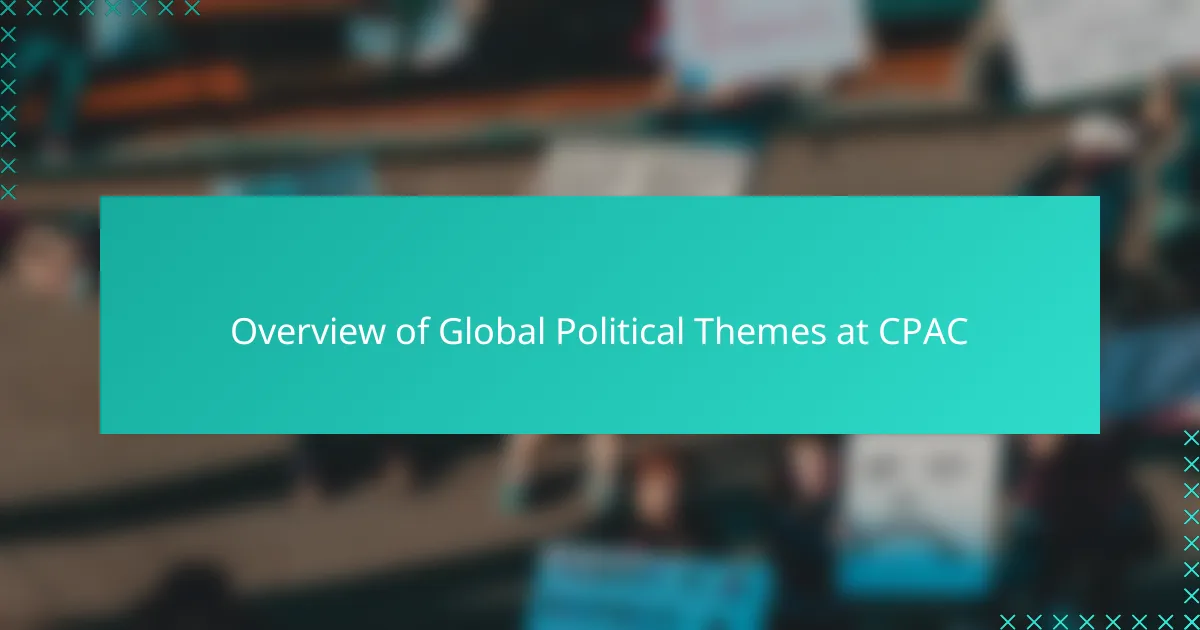
Overview of Global Political Themes at CPAC
Walking into CPAC, I quickly realized that global political themes here aren’t just background noise—they’re front and center. Issues like the rise of authoritarianism, challenges to democratic institutions, and international trade policies dominated many conversations. I found myself drawn into debates about how conservative strategies might influence not only domestic but also global political landscapes.
One moment that stayed with me was a passionate panel discussion on the shifting alliances between Western countries and emerging powers. It made me question how these realignments could reshape global security and economic stability. Hearing diverse viewpoints reminded me that the international stage is as complex as it is interconnected, and CPAC attendees are keenly aware of that.
What fascinated me most was the emphasis on sovereignty and national identity amid globalization pressures. This theme sparked lively discussions on immigration, cultural preservation, and economic independence. I couldn’t help but wonder—how will these perspectives influence policy decisions that reverberate far beyond America’s borders? For me, it was a powerful reminder that global politics isn’t abstract; it’s personal and immediate.
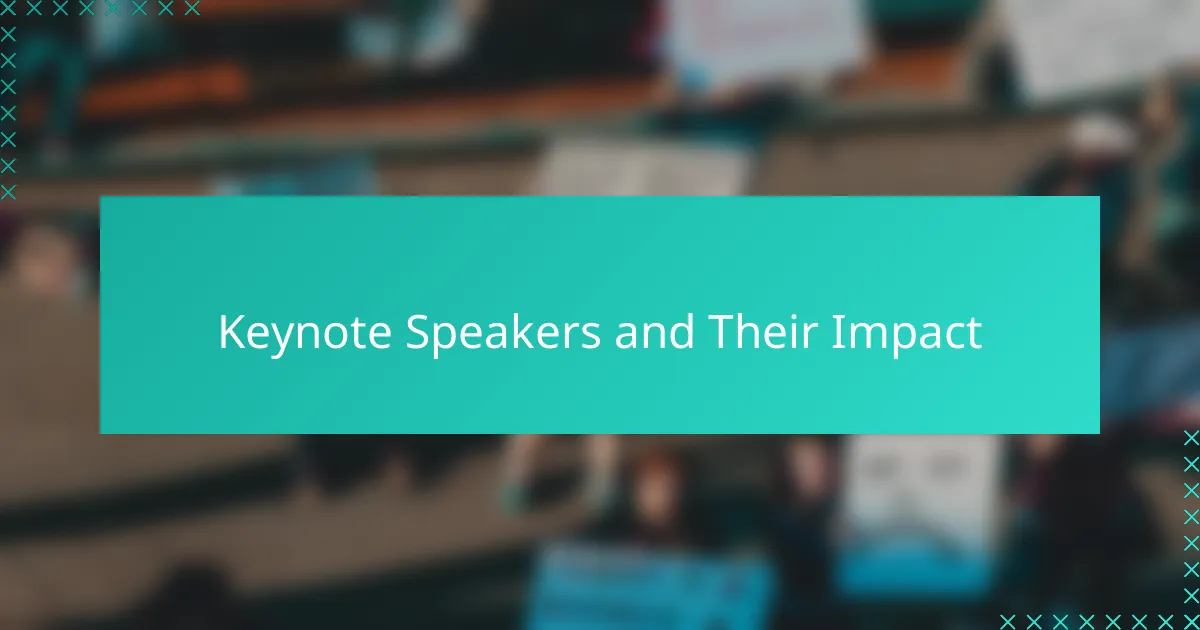
Keynote Speakers and Their Impact
Listening to the keynote speakers at CPAC was a striking experience. Their speeches often carried a blend of passion and conviction that could energize the entire room. I remember feeling a surge of motivation as one speaker challenged us to consider the broader implications of conservative principles on global governance—isn’t it powerful when words inspire action on such a scale?
What stood out to me was how these speakers didn’t just repeat familiar talking points; they introduced fresh perspectives that made me rethink certain assumptions about conservatism and its role internationally. One keynote, in particular, intertwined personal anecdotes with policy critique, making complex ideas relatable. It made me ask myself—how often do we connect policy debates with real human stories outside these events?
The ripple effect of their impact was tangible. After several speeches, conversations among attendees shifted, reflecting new insights and renewed urgency. I found myself reflecting on how influential voices can shape not just opinions but also the direction of political movements. Have you ever noticed how one compelling speech can change the tone of an entire conference? That’s exactly the kind of influence these keynote speakers wielded at CPAC.
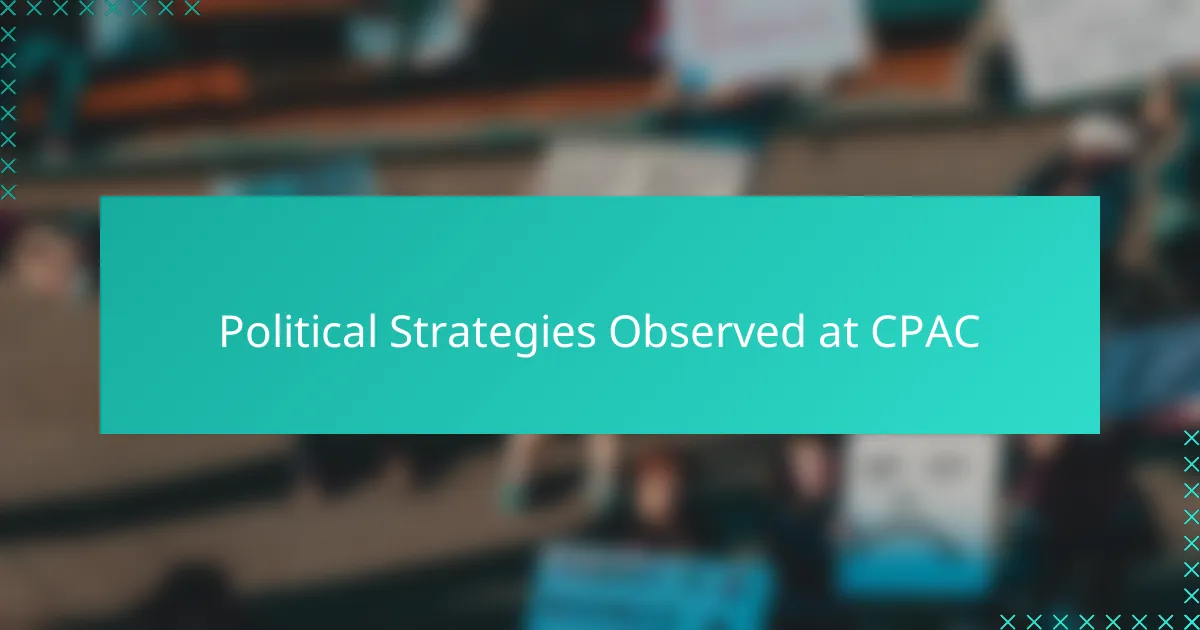
Political Strategies Observed at CPAC
What I found particularly insightful about the political strategies at CPAC was the deliberate emphasis on messaging tailored to energize the conservative base while still appealing to broader audiences. It’s fascinating to see how speakers strategically balance policy specifics with emotionally charged narratives—this dual approach seems crucial in maintaining enthusiasm and expanding influence simultaneously. Have you ever noticed how certain phrases or themes at political events resonate so deeply because they tap into shared values and concerns?
Another strategy that caught my attention was the focus on digital engagement and grassroots mobilization, which seemed more sophisticated than I expected. Observing workshops that dissected social media tactics and volunteer coordination made me realize how much groundwork happens behind the scenes to translate ideas into action. It raised the question: how do these carefully crafted campaigns adapt so quickly to changing political climates while staying true to core messages?
Lastly, I observed a strategic prioritization of issue framing to shift public discourse—whether it was about economic freedom or national security, the framing was consistent and aimed at provoking a sense of urgency and ownership among attendees. This made me think about the power of narrative control in politics; when a movement owns the story, it’s much harder for opponents to redefine it. Isn’t it intriguing how shaping the conversation itself becomes a winning strategy in today’s polarized environment?
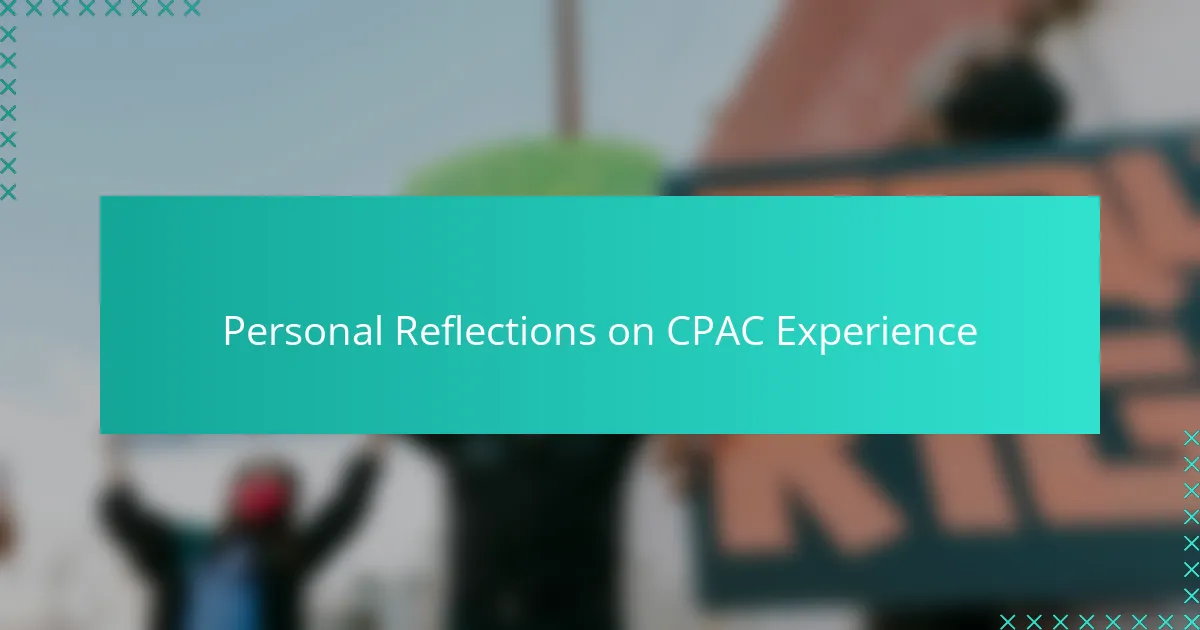
Personal Reflections on CPAC Experience
Being at CPAC gave me a real sense of immersion in a community driven by passion and purpose. I remember the buzz in the air when participants from different backgrounds leaned in to hear each other’s viewpoints, proving that even within shared ideologies, there’s room for lively debate and growth. It made me wonder—how often do we get to witness political energy that’s both intense and inclusive?
There was a moment during an informal gathering where a young activist shared their vision for the future of conservatism, blending tradition with innovation. Hearing that reminded me how important it is to not only honor established principles but also to embrace new ideas, something that often gets lost in heated political discussions. Have you ever felt inspired simply by the earnest hope in someone’s voice?
Reflecting on the overall experience, I found CPAC both invigorating and thought-provoking, a place where conviction meets curiosity. It challenged me to reconsider my own views while appreciating the depth of commitment among attendees. The personal stories and strategic conversations combined left me thinking: what’s the true power of political events if not to connect people through shared yet evolving visions?
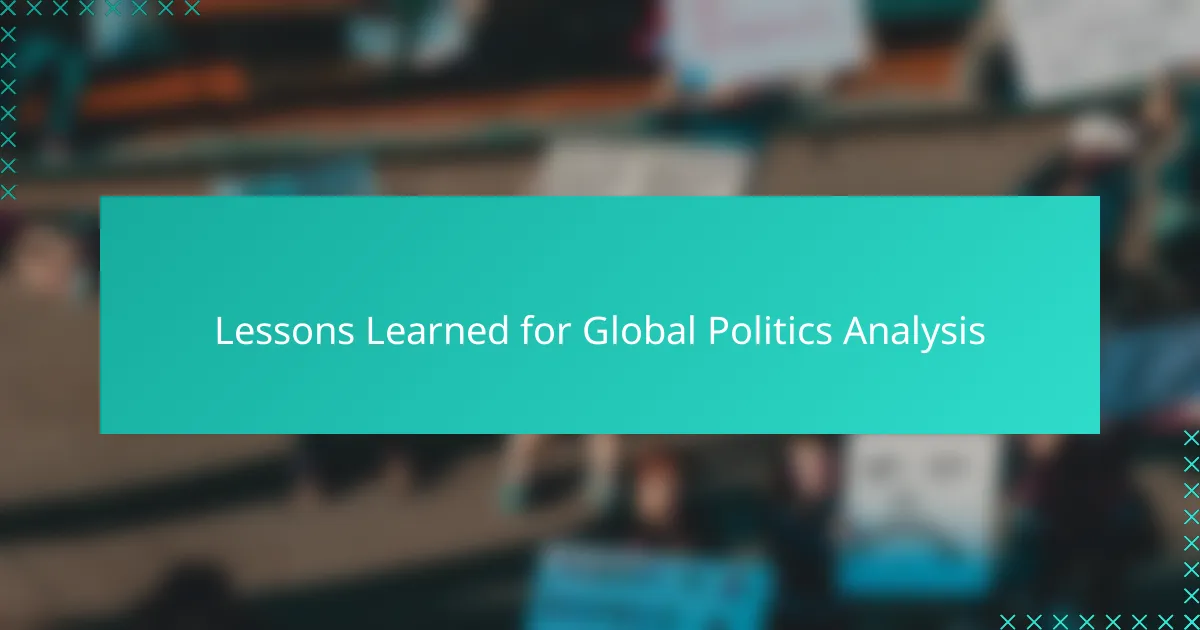
Lessons Learned for Global Politics Analysis
One lesson that really stood out to me was how important context is when analyzing global politics. At CPAC, the emphasis on national sovereignty and identity made me realize that global issues aren’t just abstract theories; they’re rooted deeply in local histories and emotions. Have you ever considered how ignoring these underlying sentiments can lead to misreading the political landscape? From my experience, overlooking cultural nuances might cause analysts to miss key drivers behind international actions.
Another takeaway involved the role of narratives in shaping political realities. Watching the strategic framing of issues at CPAC, I understood that controlling the story can be as powerful as controlling policy. It made me ask myself—how often do we, as analysts, account for the persuasive power of messaging in global affairs? Recognizing this helps avoid simplistic interpretations and reveals the subtle ways influence is exercised worldwide.
Lastly, seeing the blend of grassroots activism with high-level strategy highlighted the multi-layered nature of political power. I was struck by how closely intertwined local mobilization and global policymaking can be. This interplay suggests that true analysis requires looking beyond official statements to the networks and movements driving change. In your view, isn’t appreciating these connections crucial for anyone seeking a fuller understanding of today’s global politics?
